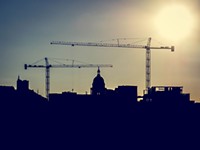Tesla Updates Travis County on Community Investments, “Ecological Paradise” Progress
Massive workforce development, still no data on water usage
By Lina Fisher, 3:10PM, Thu. Oct. 19, 2023
Tuesday, the Travis County Commissioners Court approved Tesla’s $750,000 community investment plan, to go toward community partners like the Austin Area Urban League, Colorado River Alliance, and Del Valle ISD, as the Tesla Gigafactory, the second-largest factory building in the world, prepares to release its Cybertruck.
A presentation from Tesla staff touted the many investments the company has already made in the local economy and workforce, much to the approval of commissioners. Commissioner Brigid Shea noted that “some people aren't really all that excited about the richest man in the world getting these tax exemptions, but I think it's important for people to understand what was there previously was a sand and gravel pit. And what Travis County got in property taxes from them was $642. So I'll take the $15 million in property taxes over $642 – and all of the jobs, economic benefit, and improvement in people's lives.”
That economic benefit amounts to nearly $2.2 billion paid to Travis County suppliers in 2022 alone, plus $15 million in property taxes to Travis County over the last three years, and just over $49 million to Del Valle Independent School District. Tesla funds several workforce training programs, like the P-TECH (Pathways in Technology Early College High) program at Del Valle High School, which provides students with four to five years of training culminating in a manufacturing certificate, an associate degree from ACC, and an opportunity to work at Tesla.
They also partner with ACC to offer training programs to high school grads and people with GEDs, during which they are paid as Tesla employees and receive full benefits, and can choose to work for Tesla at the end. Staff report that many do: “We've had a very good turnover rate from students to full-time employees.” Since the program’s start last year, new hires from area high schools have climbed from 50 to 200, from Del Valle, Bastrop, Elgin, Manor, and Austin.
One of the main stipulations from the county for Tesla to receive tax abatements in 2020 was the target of hiring 5,000 Travis County residents, which the manufacturer has far overshot. There are now upward of 15,000 jobs created and counting – 10,000 actual Tesla factory employees.
As Elon Musk’s properties have continued to skirt environmental regulation elsewhere in Texas (namely the Boring Co. in Bastrop), many have had questions about the Gigafactory’s environmental impact, especially water usage, here in Travis County. Staff gave an update on Musk’s promised “ecological paradise,” manifesting in a 120-acre pilot project for ecological restoration on a stretch of land between SH 130 and FM 973, west of the factory. The previous sand and gravel operation that the land was used for has made planting difficult, but with the help of compost the soil has been revitalized enough to now house 30-plus species of trees, 5,000 native plant species, and over 2,000 wetland plants in shallow water zones. Tesla has also removed 50 acres of invasive species and planted wildflowers.
Tesla again did not have exact numbers when Commissioner Shea asked about water usage for the entire factory, so the previous estimate of 600 million gallons a year still stands – though staff noted that as production ramps up that is likely to change (read: increase). The factory does use treated wastewater from Austin Water, and is planning to build more reclaimed water lines to feed the factory building. Cooling systems are also fed by a massive rainwater capture system that collects what rain does fall (not much lately) from the roof and directs it to 500,000-gallon-capacity storage tanks which are then redirected to cooling the offices and the equipment used to make the Cybertrucks. Tesla estimates that system saves about 8 million to 10 million gallons of water a year, but again: With what rain?
“The city of Austin's main water supply has been declining because there's so little flow in any of the contributing streams that feed into Lake Travis. And there's a growing demand,” noted Shea, urging Tesla to do “anything that can be done to reuse water in your manufacturing process. It would be really useful to understand what other kinds of things that you're doing internally that would reduce the overall demand for water, because it's going to be such a huge problem in the region.”
Got something to say on the subject? Send a letter to the editor.
A note to readers: Bold and uncensored, The Austin Chronicle has been Austin’s independent news source for over 40 years, expressing the community’s political and environmental concerns and supporting its active cultural scene. Now more than ever, we need your support to continue supplying Austin with independent, free press. If real news is important to you, please consider making a donation of $5, $10 or whatever you can afford, to help keep our journalism on stands.
June 28, 2024
June 28, 2024
Tesla, Boring Co., Brigid Shea, Cybertruck









